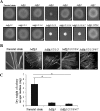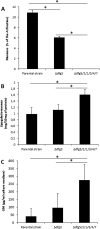The Glycosylphosphatidylinositol-Anchored DFG Family Is Essential for the Insertion of Galactomannan into the β-(1,3)-Glucan-Chitin Core of the Cell Wall of Aspergillus fumigatus
- PMID: 31366710
- PMCID: PMC6669337
- DOI: 10.1128/mSphere.00397-19
The Glycosylphosphatidylinositol-Anchored DFG Family Is Essential for the Insertion of Galactomannan into the β-(1,3)-Glucan-Chitin Core of the Cell Wall of Aspergillus fumigatus
Abstract
The fungal cell wall is a complex and dynamic entity essential for the development of fungi. It is composed mainly of polysaccharides that are synthetized by protein complexes. At the cell wall level, enzyme activities are involved in postsynthesis polysaccharide modifications such as cleavage, elongation, branching, and cross-linking. Glycosylphosphatidylinositol (GPI)-anchored proteins have been shown to participate in cell wall biosynthesis and specifically in polysaccharide remodeling. Among these proteins, the DFG family plays an essential role in controlling polar growth in yeast. In the filamentous fungus and opportunistic human pathogen Aspergillus fumigatus, the DFG gene family contains seven orthologous DFG genes among which only six are expressed under in vitro growth conditions. Deletions of single DFG genes revealed that DFG3 plays the most important morphogenetic role in this gene family. A sextuple-deletion mutant resulting from the deletion of all in vitro expressed DFG genes did not contain galactomannan in the cell wall and has severe growth defects. This study has shown that DFG members are absolutely necessary for the insertion of galactomannan into the cell wall of A. fumigatus and that the proper cell wall localization of the galactomannan is essential for correct fungal morphogenesis in A. fumigatusIMPORTANCE The fungal cell wall is a complex and dynamic entity essential for the development of fungi. It is composed mainly of polysaccharides that are synthetized by protein complexes. Enzymes involved in postsynthesis polysaccharide modifications, such as cleavage, elongation, branching, and cross-linking, are essential for fungal life. Here, we investigated in Aspergillus fumigatus the role of the members of the Dfg family, one of the 4 GPI-anchored protein families common to yeast and molds involved in cell wall remodeling. Molecular and biochemical approaches showed that DFG members are required for filamentous growth, conidiation, and cell wall organization and are essential for the life of this fungal pathogen.
Keywords: Aspergillus fumigatus; cell wall; glycobiology.
Copyright © 2019 Muszkieta et al.
Figures








Similar articles
-
Two KTR Mannosyltransferases Are Responsible for the Biosynthesis of Cell Wall Mannans and Control Polarized Growth in Aspergillus fumigatus.mBio. 2019 Feb 12;10(1):e02647-18. doi: 10.1128/mBio.02647-18. mBio. 2019. PMID: 30755510 Free PMC article.
-
Specific molecular features in the organization and biosynthesis of the cell wall of Aspergillus fumigatus.Med Mycol. 2005 May;43 Suppl 1:S15-22. doi: 10.1080/13693780400029155. Med Mycol. 2005. PMID: 16110787 Review.
-
Biosynthesis of the fungal cell wall polysaccharide galactomannan requires intraluminal GDP-mannose.J Biol Chem. 2012 Dec 28;287(53):44418-24. doi: 10.1074/jbc.M112.398321. Epub 2012 Nov 8. J Biol Chem. 2012. PMID: 23139423 Free PMC article.
-
A molecular vision of fungal cell wall organization by functional genomics and solid-state NMR.Nat Commun. 2021 Nov 3;12(1):6346. doi: 10.1038/s41467-021-26749-z. Nat Commun. 2021. PMID: 34732740 Free PMC article.
-
GPI Anchored Proteins in Aspergillus fumigatus and Cell Wall Morphogenesis.Curr Top Microbiol Immunol. 2020;425:167-186. doi: 10.1007/82_2020_207. Curr Top Microbiol Immunol. 2020. PMID: 32418035 Review.
Cited by
-
Glycosylphosphatidylinositol Anchors from Galactomannan and GPI-Anchored Protein Are Synthesized by Distinct Pathways in Aspergillus fumigatus.J Fungi (Basel). 2018 Feb 2;4(1):19. doi: 10.3390/jof4010019. J Fungi (Basel). 2018. PMID: 29393895 Free PMC article.
-
Structural adaptation of fungal cell wall in hypersaline environment.Nat Commun. 2023 Nov 4;14(1):7082. doi: 10.1038/s41467-023-42693-6. Nat Commun. 2023. PMID: 37925437 Free PMC article.
-
A Novel CFEM Effector in Fusarium verticillioides Required for Virulence Involved in Plant Immunity Suppression and Fungal Cell Wall Integrity.Int J Mol Sci. 2025 May 4;26(9):4369. doi: 10.3390/ijms26094369. Int J Mol Sci. 2025. PMID: 40362606 Free PMC article.
-
Structural base for the transfer of GPI-anchored glycoproteins into fungal cell walls.Proc Natl Acad Sci U S A. 2020 Sep 8;117(36):22061-22067. doi: 10.1073/pnas.2010661117. Epub 2020 Aug 24. Proc Natl Acad Sci U S A. 2020. PMID: 32839341 Free PMC article.
-
Functional Coupling between the Unfolded Protein Response and Endoplasmic Reticulum/Golgi Ca2+-ATPases Promotes Stress Tolerance, Cell Wall Biosynthesis, and Virulence of Aspergillus fumigatus.mBio. 2020 Jun 2;11(3):e01060-20. doi: 10.1128/mBio.01060-20. mBio. 2020. PMID: 32487759 Free PMC article.
References
-
- Muszkieta L, Aimanianda V, Mellado E, Gribaldo S, Alcàzar-Fuoli L, Szewczyk E, Prevost M-C, Latgé J-P. 2014. Deciphering the role of the chitin synthase families 1 and 2 in the in vivo and in vitro growth of Aspergillus fumigatus by multiple gene targeting deletion. Cell Microbiol 16:1784–1805. doi:10.1111/cmi.12326. - DOI - PubMed
Publication types
MeSH terms
Substances
Grants and funding
LinkOut - more resources
Full Text Sources

